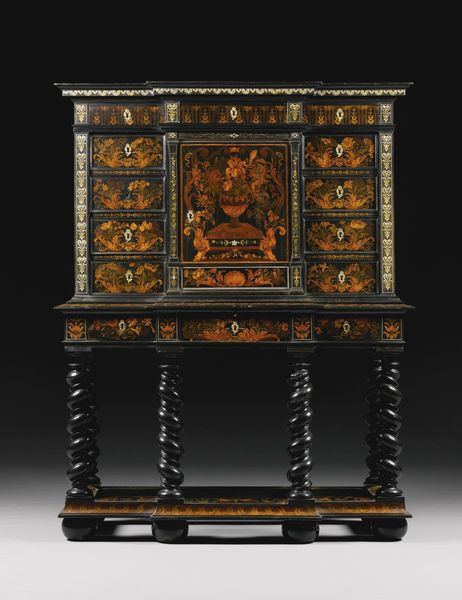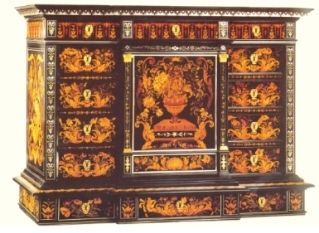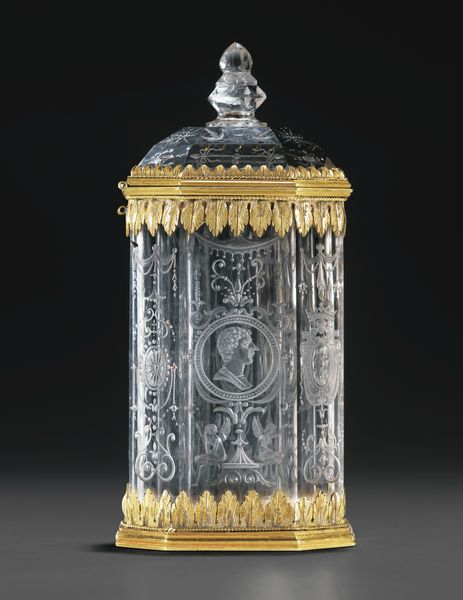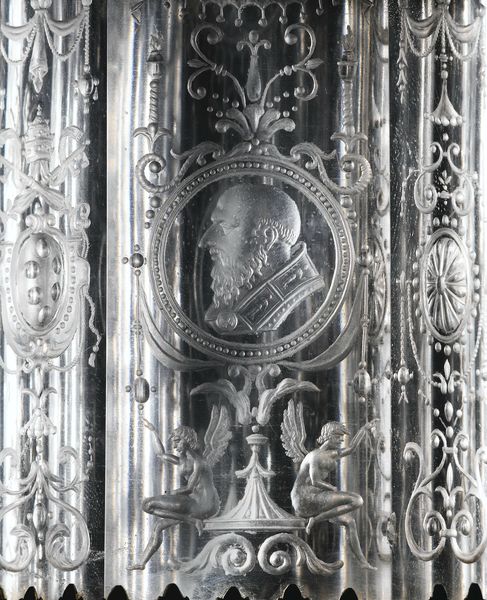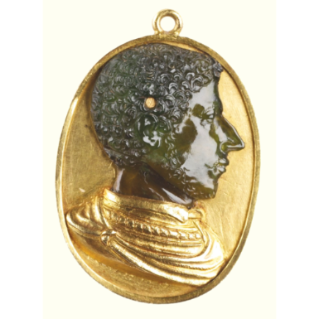![631L13303_6Z26H_1]()
![634L13303_6Z26H_4]()
![637L13303_6Z26H_7]()
![639L13303_6Z26H_9]()
A magnificent late Renaissance antique marble inlaid table top, Roman, last quarter 16th century. Photo courtesy Sotheby's
an inlaid antique marble table top (commesso) of rectangular form, centred by a lavish oval medallion of rare breccia quintilina, in turn surrounded by an oval border of shields in breccia marina and lapis lazuli, peltae in alabastro fiorito, lozenges in alabastro tartarugato, the symmetrical cartouches inlaid with stylised palmettes of giallo antico and rosso antico, the thin outer border with stylised ovals and diapers of mother-of-pearl, coral and cotognino, the central rectangular section with a verde antico ground inlaid with stylised strapwork and scrolls in alabastro listato, each corner with a broccatello di Spagna cartouche with four-petalled corollas, the cartouche ending in a stylised lily or fleur-de-lys of lapis lazuli and rosso antico, each cartouche centred by an oval plaque with an inlaid pietra dura bird on a branch, the exception of one oval plaque bearing a cockerel on a branch, the shorter sides with a stylised peltae in semesanto, the outer border discreetly interspersed with lapis lazuli on a ground of brocatello di Spagna, with elongated cartouches of breccia quintilina with alternating roundels in breccia d’aleppo and lumachella di Tunisi, the border on all sides centred with a rectangle of bianco e nero d’aquitania surrounded by rosso antico, each corner with an oval of alabastro listato burgeoning an acorn of lapis lazuli and set within a fragmented cartouche of bianco e nero d’aquitania, the stylised ornaments and sections on the whole outlined in white marble, theouter binding frame in nero antico; 5.5cm. high, 179cm. wide, 125.5cm. deep; 2¼in., 5ft. 10½in., 4ft. 1½in. Estimate 800,000-1,200,000 GBP
PROVENANCE: • In Florence in 1840.
• Brought to England from Florence by the Rev. Mr Sanford in 1840 with a reputed Medici provenance, according to notes kept in the family archives (at the time of its removal this table top rested on a Florentine Baroque giltwood console table. The stretcher of this console bears a posthumous Medici coat-of-arms, probably placed at the time of arrival of the top in England, a reminder of the reputed Medici provenance).
• Sold by the Rev. Mr Sanford in 1842 to the ancestors of the present owners, thence by descent.
LITTERATURE
Comparative Literature:
Bertrand Jestaz, Jean Menard et les tables de marbres romaines d’apres un document nouveau, in Melanges de l’ Ecole Francaise de Rome, 124/1, 2012, p.2-23.
Fert Sangiorgi, Documenti Urbinati, Inventari Del Palazzo Ducale (1582–1631), Collana Di studi e Testi 4, Accademia Raffaello, Urbino, Preface, di Pasquale Rotondi, Rome 1976.
Alvar González-Palacios, Las Colecciones Reales Españolas De Mosaicos y Piedras Duras, Museo Nacional del Prado, Madrid, 2001.
Anna Maria Giusti, Pietre Dure Hardstone in Furniture and Decorations, London, 1992.
Anna Maria Giusti, a cura di, Eternità e Nobiltà di Materia Itinerario artistico fra le pietre policrome, Edizioni Polistampa, Firenze, 2003.
Wolfram Koeppe & Anna Maria Giusti, Art of the Royal Court, Treasures in Pietre Dure from the Palaces of Europe, The Metropolitan Museum of Art, New York, 2008.
Filippo Tuena, I marmi di Commesso nel tardo rinascimento romano, p. 80, in a cura di Gabriele Borghini, Marmi antichi; Rome, 1997.
NOTE: This magnificent late-Renaissance table top, previously unknown and studied here for the first time, comes from one of England's most prestigious stately homes. It is certainly one of the largest and most beautiful geometrically designed Roman antique marble inlaidcommesso ever conceived.
The exquisite quality and exceptional magnitude of this work of art is enhanced by the clever use of rare antique marbles excavated from Roman Imperial ruins.
Produced at the pinnacle of Roman intarsia craftsmanship and technical virtuosity, at a time when the Renaissance princely dynasties of the 16th century also vied for power through their assertion of artistic patronage, the sheer significance of this rare inlaid table top is magnified by the precious, resilient and timeless material used, thereby symbolically emulating the dynastic gravitas and continuity of its owners.
For its grand scale, the supreme quality of the antique marbles employed and the complexity of the geometric and rigorous design, this table top constitutes a major addition to the group of Roman commessi known of, studied and published to date.
HERALDIC SYMBOLISM AND FOUR INDICATIONS OF A POSSIBLE COMMISSION
The scale, complexity and overall quality of this work of art obviously suggests a prestigious commission. Table tops of this magnitude were commissioned and collected by the enlightened rulers of the time (Gonzaga, Farnese, Medici, .....), and almost every Italian and European Renaissance court included one or more examples ofcommessi table tops produced either in Rome or Florence.
Very few of the Renaissance inlaid table tops known and researched so far bear heraldic symbols or coat-of-arms which would obviously help to identify the patron who commissioned them, even in the absence of documentary evidence.
Despite the fact that at present no precise documents have been traced to identify the original commission and location of this commesso, one should pay attention to the four acorns, the fruit of the oak tree inlaid at each corner, which may represent the emblems of the original owner.
No other Roman commessi are known to depict acorns, a fruit rarely represented in art, and the presence of these acorns, cleverly positioned on the four corners of this tabletop, does not seem accidental.
The simple acorn fruit, together with the leaves of the oak tree were the emblems of the very elaborate coat-of-arms of the Della Rovere family, who ruled the Dukedom of Urbino, a refined court whose importance would surely have justified the presence of similar works of art in their collections.
Both dukes of Urbino, Guidobaldo II della Rovere (1514-1574), who married Vittoria Farnese, and their son Francesco Maria II della Rovere (1549–1631) were avid collectors and very often the works of art commissioned by them were adorned with the emblems of their coat-of- arms ( see for example the table sold in these rooms on 5th July 2010, Lot 6 and fully catalogued and researched by Prof. Alvar Gonzalez Palacios).
In an 1582 inventory of the Palazzo Ducale in Urbino (before the court moved to Pesaro), a most interesting entry is found at number 126 and which, if the Della Rovere provenance is taken into consideration, could well refer to our table. It describes:
"Tavole di noce con marmo: 126 .Una tavola di noce granda intarsiata de diversi marmi et pietre mischie, dentro la quale vi sono Quattro quadri di paragone, con cornige a capre che servano per piedi." (Fert Sangiorgi, Documenti Urbinati, Inventari del Palazzo Ducale, 1582-1631, Urbino, 1976, page 32.) which translates to describe 'a large walnut table inlaid with diverse marbles and various stones, inside which there are four rectangles in paragone' (a type of black marble).
One cannot fail to notice that the outer border of the present large table top also boasts four rectangles, but instead inlaid with bianco e nero d’Aquitania marble. Nonetheless, it should be mentioned that all the entries of the abovementioned inventory are very generic and without sizes and that the guardarobieri, that is to say, the members of the courts who carried out the inventories, were not experts themselves and therefore they could easily have mistaken the more rare and prized aquitania marble (black and white) for paragone (black marble), a term generally used. Moreover, paragone is usually used as a background stone and therefore not sufficiently important enough to be inset in four reserves on an important inlaid top. Interestingly, the person who carried out the inventory does however record the large size of the table, similar to the present one and the fact that both diversi marmi e pietre mischie’ are mentioned seems to stress the variety of materials employed. Furthermore, it should be noted that a technical analysis taken of the thick border (almost 6cm) suggests that our table never had the usual moulded border (so called a becco di civetta) found on other tables, as it was possibly envisaged to be inset in a Renaissance walnut stand.
![6JSL2_Comp_7]()
![6JSL2_Comp_8]() On the same axis of each acorn, a stylised lily or fleur-de-lys rests. Unlike the acorns, stylised lilies are recorded on some Roman commessi and even on a preparatory drawing (see figs 4 & 7) and so in this case we could perhaps simply be presented with a decorative motif and not of the heraldic symbol of the Farnese family. However, should a possible Della Rovere provenance be forthcoming, it should be observed that the mother of Francesco Maria II was in fact Vittoria Farnese (1521–1602), niece of Pope Paul III and sister of Cardinal Allesandro Farnese (who commissioned the celebrated Farnese table now at the Metropolitan Museum of Art, New York and several others).
On the same axis of each acorn, a stylised lily or fleur-de-lys rests. Unlike the acorns, stylised lilies are recorded on some Roman commessi and even on a preparatory drawing (see figs 4 & 7) and so in this case we could perhaps simply be presented with a decorative motif and not of the heraldic symbol of the Farnese family. However, should a possible Della Rovere provenance be forthcoming, it should be observed that the mother of Francesco Maria II was in fact Vittoria Farnese (1521–1602), niece of Pope Paul III and sister of Cardinal Allesandro Farnese (who commissioned the celebrated Farnese table now at the Metropolitan Museum of Art, New York and several others).
It is as if the lily is pointing to the acorn, alluding to a correlation between the two and conceding then that perhaps the intention in design is rather poignant. The use of lapis lazuli, one of the most luxurious stones in the table, seems also not to have been placed by chance, but instead has been possibly positioned to accentuate the heraldic motifs and to stress the importance of the patrons. Finally, mention should be made of the three cartouches, each centred by an oval depicting a bird on a branch and a curious fourth depicting a cockerel, the symbol of which connotes vigilance, courage and an emblem of watchfulness and honour in victory.
Denoting their largely ‘arcaic’ design, the birds and cockerel could represent the first timid appearance of naturalistic elements on Roman tops, which are otherwise known for their geometric layout, and in contrast with the more naturalistic inlaid hardstone tops produced in Florence. At the time, exchanges between Florence and Rome were frequent as the craftsmen moved from one city to the other. One could therefore not exclude the intervention of a Florentine craftsman with regard to the naturalistic elements.
It was only towards the very end of the century and into the early part of the seventeenth century that basic figurative elements like tendrils, flowerheads, military trophies and more elaborate birds fully appear on Roman tops and where they were combined and integrated with the more traditional geometric shapes.
A technical analysis on these ovals does not seem to suggest that they are later 18th or early 19th century replacements. However, should an antique replacement have taken place, various open ended questions could be asked: did these ovals contain another variety of precious antique marble, with perhaps a more elaborate coat of arms? Was this table top at some stage moved to Florence, which seems to be suggested to in the family archives of the present owner, when acquired in 1842? Should the reputed Medici provenance, together with the suggested Della Rovere link be substantiated, then it is worthwhile recording the movement of some of the art collections from Francesco Maria II Della Rovere to the Medici family, via his grand-daughter Vittoria della Rovere ( 1622-1694) spouse of Grand Duke Ferdinand II de Medici (1610-1670).
THE TASTE FOR MARBLES FROM ANTIQUITY
Early sixteenth century Rome was the catalyst of High Renaissance culture, when artists, intellectuals, writers and potentates endeavoured to mirror the works of the ancients with a renewed and passionate interest in the culture of Classical Antiquity. Throughout this century and beyond, the Eternal City promoted archaeological discoveries and excavations amidst the quest for rare and beautiful stones and marbles from southern Italy, Greece, Africa and Asia Minor, which once embellished the majestic private and public buildings and temples of Imperial Rome. This notion consequently attracted enlightened princes and fervent collectors of antique marbles from all over Europe. Marble work and in particularopus sectile, an innovative mosaic technique of placing together irregular sections of coloured stone to create floors and adorn walls, was being discovered during the archaeological excavations of the sixteenth century.
This legacy of marble working lasted throughout the Middle Ages and it was revived and perfected by the Mannerist craftsmen of commesso (from the Latin verb, committere, meaning to join together).
With columns and fragments of every kind of marble and coloured stone found deposited everywhere in the city, Renaissance artisans would collect these, cut them accordingly and use them to decorate the churches, palazzos, monuments and furniture. An example of this is visible on the present table top, which epitomises the zenith of Renaissance Roman craftsmanship and virtuosity.
The present antique marble inlaid table top, a vision of elegance, grandeur and vibrancy, is a tribute to those extraordinary Imperial Roman marbles.
The extremely rare and very large breccia quintilina in the central oval adds to the value and importance of this piece. Breccia quintilina, sometimes called breccia di Tivoli, was excavated at the site of the Villa Quintiliolo, Tivoli near the villa of Emperor Hadrian in around 1565 and thereafter became most sought after and subsequently almost disappeared. Its rarity implied that it was used either for small sections of inlays or, when used in a larger quantity, it immediately magnified the importance and the ambition of the work of art which contained it, as seen on the present table top. Another example is a Roman inlaid marble tabletop, early seventeenth century 284cm. wide, 137cm. deep, sold Sotheby’s New York, 5 November 1998, Lot 390, for $2,500,000.
The design and a few Illustrious comparisons
The present table top belongs to a particular group of important Renaissance Roman commessi, of the second half of the 16th century, all of which are characterised by:
- a large central oval (in this case made of one of the most precious and rare marbles, the breccia quintilina, here used without economy) and bordered not by one, but by three bands, richly inlaid with various stylised classical motifs;
- the presence of an elaborate cartouche (strapwork) here in alabastro listato, which contains the abovementioned oval which is in turn contained by:
- a broad outer border inlaid with pure geometric and abstract motifs which exalt the beauty of the campionario of stones displayed;
- an almost absence of naturalistic or figurative motifs (flowersheads, tendrils, trophies) which start to appear on later Roman tops.
A group of designs for works of this genre exists and could be attributed to the architect and sculptor, Giovanni Antonio Dosio (1533–1611). This further serves to strengthen the association between the decorative and the architectural in intarsia. Giovanni Antonio Dosio worked primarily in Rome and Florence. (Alvar Gonazález-Palacios, op. cit., p. 51.)
![6JSL2_Comp_6]() As seen in a design by the artist, (fig. 3) shows the distinctive design outline with the central oval and strapwork, the outer border with abstract geometric ornament set out in a symmetrical fashion, all similar to the design of the present table top. Of interest is an ornament of stylised strapwork outlined in white marble dating back to the 5th century AD on a pillar of Santa Sabina in Rome, once again showing how the Renaissance architects and craftsmen drew inspiration from the earlier designs.
As seen in a design by the artist, (fig. 3) shows the distinctive design outline with the central oval and strapwork, the outer border with abstract geometric ornament set out in a symmetrical fashion, all similar to the design of the present table top. Of interest is an ornament of stylised strapwork outlined in white marble dating back to the 5th century AD on a pillar of Santa Sabina in Rome, once again showing how the Renaissance architects and craftsmen drew inspiration from the earlier designs.
![6JSL2_Comp_5]()
(fig. 2). Another detailed drawing by Dosio (fig. 4), illustrates an abstract cartouche ending in a stylised lily, very similar to the one present on each corner of our table under the ovals containing the birds. (A Giusti, Eternità e Nobiltà di Materia, op.cit., p.66.)
Although the comparison may sound ambitious, the quality of the stones employed on the present tabletop (verde antico, broccatello, aquitania), echoes the beauty and depth of those on the most celebrated Farnese table top, circa 1568 and commissioned by Cardinal Alessandro Farnese, whose emblem (the Farnese lily) is disseminated throughout the table, now in the Metropolitan Museum of Art, New York, (fig. 7). It is interesting to compare the stylized strapwork around the ovals of aquitania on the Farnese table top with the bolder example around the central oval on the present table.
![6JSL2_Comp_10]() The overall composition of our table top (oval, within a border, contained in stylised abstract strapwork, framed but with a rectangle by a geometrically inlaid border) is in fact very similar to the celebrated Roman antique marble inlaid table top, late sixteenth century, formerly in the collection of Cardinal Richelieu and now in the Musée du Louvre, (200x133cm) Paris (fig. 5). The Louvre example seems to be slightly later in date due to the presence of those abovementioned tendrils which are completely absent in our table top. Apart from the central composition one should notice the strong similarities between the four beautiful stylised rosso and giallo antico palmettes, symmetrically positioned at the principal points of our oval with those scattered around the central crenelated oval of alabastro marino in the Louvre example. The discreet, yet expressive use of lapis lazuli in both these tables allows for further similarities.
The overall composition of our table top (oval, within a border, contained in stylised abstract strapwork, framed but with a rectangle by a geometrically inlaid border) is in fact very similar to the celebrated Roman antique marble inlaid table top, late sixteenth century, formerly in the collection of Cardinal Richelieu and now in the Musée du Louvre, (200x133cm) Paris (fig. 5). The Louvre example seems to be slightly later in date due to the presence of those abovementioned tendrils which are completely absent in our table top. Apart from the central composition one should notice the strong similarities between the four beautiful stylised rosso and giallo antico palmettes, symmetrically positioned at the principal points of our oval with those scattered around the central crenelated oval of alabastro marino in the Louvre example. The discreet, yet expressive use of lapis lazuli in both these tables allows for further similarities.
![777L13303_6JSL2_Comp8a]() The Louvre table, together with another late 16th century table top (150 x 98cm) in the collection of the same museum (fig. 6), a simpler commesso in the Palazzo Farnese (Rome) and a previously undocumented inlaid table (168 x 106cm) kept in the Casa de Pilatos, Seville, are discussed in an article by Bertrand Jestaz, op. cit.plates 3,4,9,10, which has been kindly brought to our attention by Prof. Alvar González-Palacios.
The Louvre table, together with another late 16th century table top (150 x 98cm) in the collection of the same museum (fig. 6), a simpler commesso in the Palazzo Farnese (Rome) and a previously undocumented inlaid table (168 x 106cm) kept in the Casa de Pilatos, Seville, are discussed in an article by Bertrand Jestaz, op. cit.plates 3,4,9,10, which has been kindly brought to our attention by Prof. Alvar González-Palacios.
Together with our table, these three tops and the table top of Seville made for the Duke d’Alcala (c.1570) (which shows empty compartments carved into the white marble which were destined to contain the marbles now lost), all share the same aforementioned composition. The Seville table is documented as having been made by Giovanni Menardo (Jean Menard, c.1525-1582), called Il Franciosino, a marble cutter active in Rome and famous for his inlaid marble tables, the same person who certainly made and possibly designed the celebrated Farnese table in the Metropolitan Museum of Art in New York. Furthermore, the Seville discovery and the table tops in the Louvre, all attributed to Jean Menard, certainly have strong design similarities to the table top here presented. The workshop of Giovanni was then continued by his brother, son and son-in-law, and one may assume that they continued to use some of the design models invented years before.
Finally, another table top, conceived without an outer broad band, but still illustrating a central oval amidst a bold strapwork is illustrated in FilippoTuena,op.cit., p. 80.
Sotheby's. Treasures, Princely Taste. London | 03 juil. 2013 - www.sothebys.com




